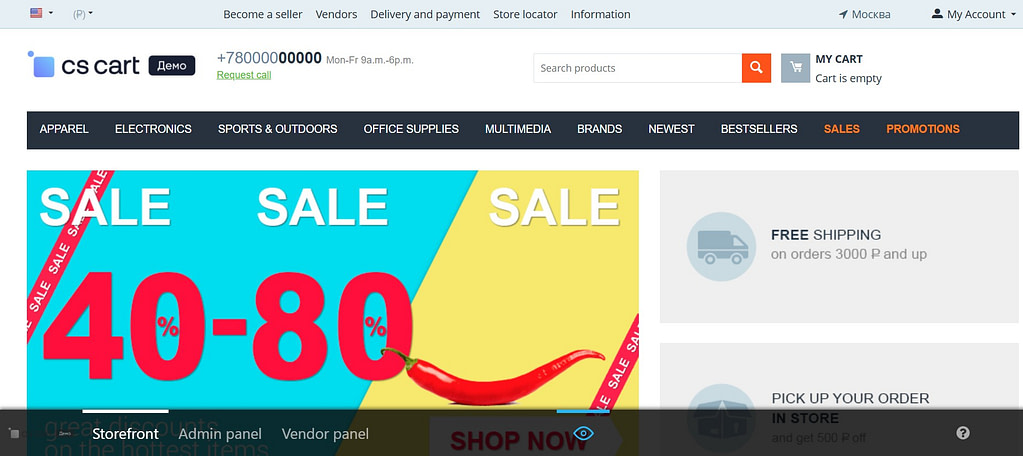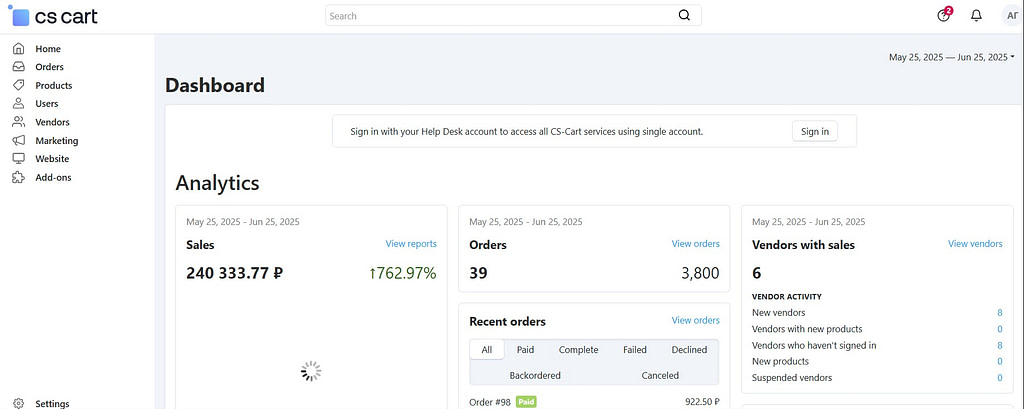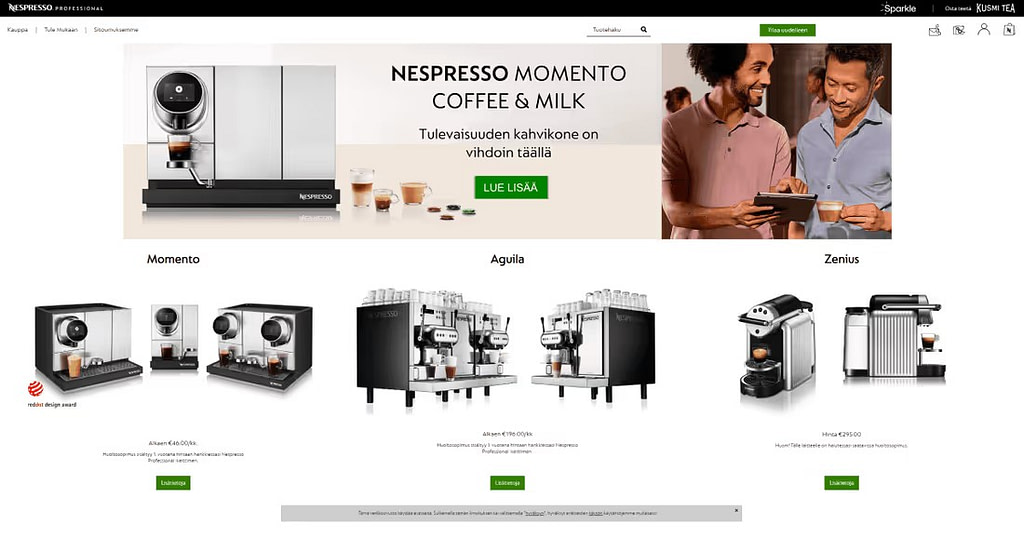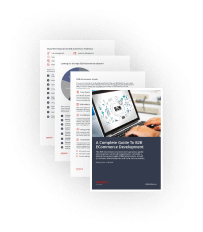In 2025, everything can be delivered to your doorstep, if not downloaded instantly. eCommerce has become the default mode of buying, selling, and building a business.
But while the concept of online shopping is familiar to most, the world of eCommerce is constantly evolving. From AI-powered personalization and social commerce to automated fulfillment and multivendor marketplaces, the tools and strategies behind digital sales are more advanced—and more accessible—than ever before.
Whether you’re a startup founder exploring online retail for the first time, or an established business rethinking your digital presence, understanding why eCommerce is important can help you build a realistic and sustainable business strategy.
In this article, we’ll break down the eCommerce advantages and disadvantages in 2025, explore why it’s such a powerful model for both businesses and consumers, and show how to use new trends in your favor.
We’ll start with the basics and move into advanced insights.
What Is eCommerce?
eCommerce, or electronic commerce, refers to the buying and selling of goods or services using the internet. It’s a dynamic, data-driven ecosystem where businesses and consumers connect across websites, mobile apps, marketplaces, and even social media platforms.
From one-person startups selling handmade goods to global enterprises running omnichannel operations, eCommerce has reshaped how people transact. Online sales now dominate many retail categories, including fashion, electronics, and digital services. And it continues to evolve—blending logistics, AI personalization, voice search, mobile payments, and real-time inventory syncing into a seamless digital experience.
Advantages of eCommerce

Now, let’s explore why online shopping matters.
Benefits of eCommerce for Businesses
The advantages of eCommerce give entrepreneurs unique opportunities to grow with fewer resources and lower risks. From the entrepreneur’s point of view, electronic commerce is a strategic advantage that enables companies of all sizes to grow faster and more efficiently. And here is why:
Lower Start-Up and Operating Costs

Online storefront example as it is done on CS-Cart
No physical storefront, no rent, and fewer staff. Digital infrastructure is far more cost-effective than brick-and-mortar, and modern eCommerce platforms allow even solo founders to launch quickly without technical teams or massive budgets. Many modern platforms allow entrepreneurs to launch their businesses without requiring deep technical expertise, thanks to no-code tools and intuitive interfaces.
24/7 Availability and Sales
An eCommerce store never sleeps. The around-the-clock availability directly contributes to customer convenience and satisfaction. Customers can browse, compare, and buy at any hour, from any time zone. This always-on model expands your reach and generates revenue beyond standard working hours.
Data-Driven Marketing and Analytics

Analytics dashboard in CS-Cart
Unlike offline retail, every click, scroll, and purchase tells a story. eCommerce gives you access to real-time data for optimizing digital marketing campaigns, predicting trends, and personalizing customer experiences at scale. These insights also help improve retention strategies and build stronger customer loyalty through targeted offers and tailored communication. For many modern businesses, eCommerce success is closely linked to effective revenue enablement strategies that align cross-functional teams around growth goals.
Scalability and Flexibility
Need to serve more customers, launch new product lines, or expand to a new region? One of the significant benefits of eCommerce is its scalability—it grows with your business without the limits of physical space or staffing.

In CS-Cart, you can scale from a standard MVP to a leading marketplace of your niche without changing the platforms and still having control over the code
Easy Integration with Business Systems
Modern eCommerce platforms connect with CRMs, ERPs, payment processors, shipping carriers, and third-party apps, streamlining your operations in one place.

Take the case of Nespresso. They introduced a unified system by interconnecting the existing platforms to have a holistic view of all operations, with all data centralized.
Read the case study: Creating an online store for Nespresso Professional distributors
Improved Inventory and Order Management
Automated stock updates, real-time order tracking, and centralized dashboards streamline inventory management and fulfillment processes, enhancing efficiency and accuracy. That means fewer delays, fewer errors, and happier customers.
You can get more insights from: Marketplace Fulfillment: How Marketplaces Deliver Orders
Advantages of eCommerce for Customers
Today’s buyers expect seamless, tailored experiences, and modern eCommerce delivers precisely that.
Convenience and Accessibility
No traffic, no lines, no store hours. Customers can shop from anywhere with an internet connection—be it during a commute or late at night. The ability to shop online has redefined consumer behavior, offering unmatched flexibility and speed.
Product Variety and Competitive Prices
Online stores offer endless aisles. With just a few clicks, customers can explore thousands of products, compare prices, and find exactly what they’re looking for—often at better prices than in-store. eCommerce offers broader product access and more frequent discounts, which keeps customers coming back.
Reviews, Ratings, and Easy Comparison
Customer reviews, star ratings, and side-by-side comparisons help buyers make informed decisions. These features reduce uncertainty, making online purchases feel more secure and transparent. Social proof builds trust, and transparency reduces buyer hesitation.
Personalized Shopping Experience
From tailored product recommendations to dynamic pricing and targeted offers, eCommerce platforms use customer data to create individualized journeys, boosting satisfaction and conversion rates. This personalization significantly enhances the online shopping experience, making each interaction feel relevant and tailored.
Disadvantages of eCommerce

While eCommerce opens incredible growth opportunities, it’s not without its challenges. Digital-first businesses face unique risks and operational complexities that brick-and-mortar stores often avoid. Understanding these disadvantages can help you prepare more effectively and develop more innovative strategies from the outset.
Security and Privacy Risks
Handling sensitive customer data—such as payment details, addresses, and login credentials—comes with a responsibility. Cyberattacks, data breaches, and fraud are real threats in eCommerce. Many businesses now use tools like IP Fraud score to detect suspicious activity early — read here to see how it helps reduce fraudulent transactions. Without robust security measures, a single incident can damage both finances and reputation.
Tip: invest in secure payment gateways, SSL encryption, and regular security audits.
Read more:
Technical Issues and Website Downtime
Your store doesn’t have doors to close, but if the site crashes or loads slowly, it might as well be shut. Downtime means lost revenue and frustrated customers, especially during peak seasons or promotions.
Tip: Choose a reliable hosting provider, monitor uptime, and regularly optimize performance. For CS-Cart owners, we recommend our Scalesta partner. They provide managed hosting with SLA guarantees and a predetermined security level.
High Competition and Market Saturation
The low barrier to entry is both a blessing and a curse. Whatever your niche, chances are, hundreds of other stores are targeting the same customers with similar products. As the eCommerce market becomes increasingly saturated, standing out requires a clear value proposition and precise execution. Standing out requires clever branding, marketing, and real value.
Learn more from: Niche Marketplaces: How to Create and Compete with eCommerce Giants
Lack of Physical Product Experience
Online customers can’t touch, try on, or test your products. This gap in sensory experience often leads to hesitation, especially with apparel, luxury goods, or tactile items. Offering clear policies and efficient systems for handling returns helps reduce hesitation and builds buyer confidence.
Get insights on the subject from: How eCommerce Can Benefit From 3D and 360 Spin Images?
Shipping Delays and Fulfillment Challenges
Even with automated systems, logistics can be unpredictable. Stockouts, customs issues, courier delays, or supply chain disruptions can hurt the customer experience and damage brand credibility. Poor fulfillment can quickly lead to lost sales and negative reviews if customers experience unexpected delays.
Limited Personal Interaction with Customers
Online interactions often lack the human touch that in-store experiences provide. That can make it harder to build trust, resolve concerns, or guide hesitant buyers toward a purchase.
We’ve already explored this issue in: Implementing Conversational Strategy: Does eCommerce Need Chats?
Legal, Tax, and Compliance Complexities
From cross-border tax rules to GDPR and local eCommerce regulations, running an online store means navigating a complex legal landscape that varies by region.
For Choplocal, we’ve introduced functionality that allows the platform to automatically determine whether a vendor is permitted to sell in a particular state human factor, resulting in fewer troubles with the government.
IT and Website Maintenance Costs
While you don’t have to lease or furnish a retail space, your digital store still requires ongoing investment. Although cheaper than a physical storefront, maintaining an eCommerce site still incurs ongoing costs, including software updates, web hosting fees, technical support, and occasional redesigns or security upgrades.
Tip: budget for regular maintenance and choose scalable platforms that reduce manual upkeep. Choose the eCommerce software that will expand with your business. A fast, secure, and well-maintained site is critical for ensuring high customer satisfaction in online shopping. From day one, introduce the site architecture capable of maintaining this growth.

At Simtech Development, we develop a project structure based on business analysis to encompass all sections of the online project, building an eCommerce experience that endures for years.
Difficulties in Building Customer Trust
New online stores often face skepticism, especially when they lack brand recognition or social proof. Visitors may worry about the quality, refunds, or whether the store is legitimate.
Tip: Use verified reviews, trust badges, secure checkout flows, and a professional-looking design to build credibility from the very first click.
Get more ideas from: eCommerce Trust | How to Build Trust in an eCommerce
Is eCommerce Right for Your Business?
Online commerce offers a compelling path to growth, but it’s not a universal solution. You need to evaluate the pros and cons of online shopping in the context of your audience, products, and operational capacity. Before diving in, it’s vital to assess whether the model aligns with your product, audience, and long-term strategy.
Know Your Audience and Product Fit
Not every product sells well online. Perishable goods, hyper-local services, or high-touch luxury items may need more physical presence. Similarly, your target audience must be comfortable shopping online, whether through a website, app, or social platforms. In many industries, consumers are increasingly opting for online shopping due to its speed, convenience, and broader selection.
Ask yourself:
- Where does my audience spend their time—online or offline?
- Do they value convenience over in-person experience?
- Is my product easy to evaluate without physical inspection?
Assess the Competition
High competition can be a double-edged sword—it validates demand, but also raises the bar. Study what competitors are doing well, where they’re lacking, and how you can position yourself differently.
Look for:
- Gaps in customer service or product selection
- Opportunities for better UX or faster delivery
- Unmet needs in niche subcategories
Align with Business Goals and Capacity
Running an eCommerce business requires time, tools, and commitment. If your team is already stretched thin or your operations aren’t digitized, you may need to phase your approach or start small.
Checklist:
- Do I have resources for marketing, fulfillment, and support?
- Can I handle orders at scale, or do I need automation?
- Will eCommerce complement or distract from my core business model?
Conclusion: Weigh the Risks, Embrace the Potential
eCommerce is a transformative business model that can pave the way for flexibility and data-driven growth. But success doesn’t happen by accident. It requires thoughtful planning, the right technology, and a deep understanding of your customers.
If you’re willing to invest in the foundation—from platform choice to customer experience—eCommerce can help you build a scalable, future-ready business.
Start by defining your niche, exploring tools that align with your goals, and mapping the customer journey from the first click to repeat purchase. A professionally built eCommerce website is the foundation of this journey, turning visitors into loyal customers.
At Simtech Development, we help businesses turn these plans into action. Whether you’re launching your first online store or scaling a complex marketplace, our team supports you with tailored development, integrations, UX enhancements, and long-term eCommerce strategy, based on the CS-Cart platform and beyond.
Let’s build an eCommerce experience together!

